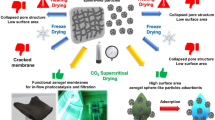Abstract
Immobilization of recombinant Thermomyces lanuginosus lipase (designated as rPichia/lip) was carried out by moisture capacity impregnation of mesoporous silica granules followed by drying, and forcible adsorption of enzyme occurred. Eventually prepared lipase-active heterogeneous biocatalysts were systematically studied for enzymatic esterification performed at ambient conditions (20 ± 2 °C, 1 bar) in unconventional anhydrous media of organic solvents such as hexane and diethyl ether. The saturated fatty acids differing in the number of carbon atoms (C2–C10, C18), and aliphatic alcohols differing in the structure of the molecules, namely both the number of carbon atoms (C2–12, C16), and the isomerism of the carbon skeleton (n- and iso-), and OH-group position (prim-, sec-, tert-) were studied as substrates for enzymatic esterification. The specificity of the heterogeneous enzymatic esterification was determined by comparing the reaction rates for various pairs of substrates; and the matrix of relative units of activities was composed. The immobilized on silica rPichia/lip was found to have sufficiently wide specificity toward saturated fatty acids and aliphatic alcohols. High reaction rates were measured in esterification of fatty acids and primary n- and iso-aliphatic alcohols possessing more than four carbon atoms in the molecules. The enanthic acid (heptanoic, C7:0) reacted with butanol (C4) with the highest rate; and the kinetic parameters such as Michaelis constant (KM) for acid and maximal reaction rate (Vmax) were determined under the studied conditions of esterification. Substrates containing aromatic residues did not participate in esterification. The lipase-active heterogeneous biocatalysts possessed considerably high operational stability, and the catalytic activity was completely retained for several tens of reaction cycles in a periodic batch process of low-temperature synthesis of various fatty acid esters.




Similar content being viewed by others
References
Grunwald P (2009) Biocatalysis. Imperial College Press, London
Tao J, Kazlauskas R (2011) Biocatalysis for green chemistry and chemical process development. Wiley, Hoboken
Sun J, Lee L, Liu S (2014) Aust J Chem 67:1373–1381
Talon R, Montel M, Berdague J (1996) Enzym Microb Technol 19:620–6228
Hsu A, Foglia T, Siya S (2000) Biotechnol Appl Biochem 31:179–183
Pinto M, Freire D, Pinto J (2014) Molecules 19:12509–12530
Silveira E, Moreno-Perez S, Basso A, Serban S, Mamede R, Tardioli P, Farinas C, Rocha-Martin J, Fernandez-Lorente G, Guisan J (2017) BMC Biotechnol 17:88–101
Mulalee S, Srisuwan P, Phisalaphong M (2015) Chin J Chem Eng 23:1851–1856
Gandhi N, Mukherjee K (2001) J Am Oil Chem Soc 78:161–165
Lopresto C, Calabro V, Woodley J, Tufvesson P (2014) J Mol Catal B 110:64–71
Raita M, Kiatkittipong W, Laosiripojana N, Champreda V (2015) Chem Eng J 278:19–23
Pang J, Zhou G, Liu R, Li T (2016) Mater Sci Eng C 59:35–42
Chang S, Shaw J (2009) New Biotechnol 26:109–116
Sutili F, Ruela H, Leite S, Miranda L, Leal I, Souza R (2013) J Mol Catal B 85–86:37–42
Gumel A, Annuar M, Heidelberg T, Chisti Y (2011) Process Biochem 46:2079–2090
Enayati M, Gong Y, Goddard J, Abbaspourrad A (2018) Food Chem 266:508–513
Jia C, Wang H, Zhang W, Zhang X, Feng B (2018) Process Biochem 66:28–32
Bernal C, Escobar S, Wilson L, Illanes A, Mesa M (2014) Carbon 74:96–103
Wang Z, Du W, Dai L, Liu D (2016) J Mol Catal B 127:11–17
Guebara S, Ract J, Vitolo M (2018) Arab J Sci Eng 43:3631–3637
Cavalcanti E, Aguieiras É, da Silva P, Duarte J, Cipolatti E, Fernandez-Lafuente R, da Silva J, Freire D (2018) Fuel 215:705–713
Fernandes K, Papadaki A, da Silva J, Fernandez-Lafuente R, Koutinas A, Freire D (2018) Ind Crops Product 116:90–96
Akerman C, Hagström A, Mollaahmad M, Karlsson S (2011) Hatti-Kaul. Process Biochem 46:2225–2231
Kim H, Choi N, Kim Y, Kim H, Lee J, Kim I (2019) Renew Energy 130:489–494
Verdasco-Martin C, Garcia-Verdugo E, Porcar R, Fernandez-Lafuente R, Otero C (2018) Food Chem 245:39–46
Naik S, Basu A, Saikia R, Madan B, Paul P, Chaterjee R, Brask J, Svendsen A (2010) J Mol Catal B 65:18–23
Arsan J, Parkin K (2000) Biotechnol Bioeng 69:222–226
Perminova L, Kovalenko G, Chukanov N, Patrushev Y (2017) Rus Chem Bull 11:2194–2197
Kovalenko G, Perminova L, Chuenko T, Rudina N (2016) Appl Biochem Microbiol 52:582–588
Bearden J (1978) Biochim Biophys Acta 533:525–529
Kovalenko G, Perminova L, Beklemishev A, Mamaev A, Patrushev Y (2018) Catal Ind 10:68–74
Mahapatra P, Kumari A, Garlapati V, Banerjee R, Nag A (2009) J Mol Catal B 60:57–63
Acknowledgements
Authors are grateful to Maria B. Pykhtina for cultivation of the rPichia/lip strain-producer for this research. This work was conducted within the framework of the budget Project No. AAAA-A17-117,041,710,075-0.
Author information
Authors and Affiliations
Corresponding author
Additional information
Publisher's Note
Springer Nature remains neutral with regard to jurisdictional claims in published maps and institutional affiliations.
Rights and permissions
About this article
Cite this article
Kovalenko, G.A., Perminova, L.V. & Beklemishev, A.B. Catalytic properties of recombinant Thermomyces lanuginosus lipase immobilized by impregnation into mesoporous silica in the enzymatic esterification of saturated fatty acids with aliphatic alcohols. Reac Kinet Mech Cat 128, 479–491 (2019). https://doi.org/10.1007/s11144-019-01648-z
Received:
Accepted:
Published:
Issue Date:
DOI: https://doi.org/10.1007/s11144-019-01648-z




